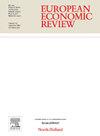全球生产网络中的碳税
IF 2.4
2区 经济学
Q1 ECONOMICS
引用次数: 0
摘要
本文研究了考虑全球生产网络结构的碳税问题。为此,我们描述了在一个国家-部门实施碳税如何通过其对生产结构的影响对全球排放和福利产生巨大波动。然后,我们应用这一理论特征来适应多区域投入产出数据库的结构。这个框架使我们能够确定在没有协调政策的情况下,应该对哪些国家部门征税,以达到最大的减排潜力(或福利最大化)。有趣的是,这一选择不仅取决于排放强度,还取决于该部门在全球生产网络中的中心地位,以及对公共或私人支出的传递效应。此外,我们发现,不同国家和行业征收的碳税之间的协同效应对减排具有强大的影响,这呼吁在全球范围内加强碳税的协调。然后,我们使用我们的模型来模拟欧洲碳边界调整机制(CBAM)的影响,发现当逐个行业研究时,它减少了欧盟因碳定价而导致的竞争力损失,但当推广到所有欧盟部门时,通过价值链的影响最终引发了欧盟比没有CBAM更强的收缩。本文章由计算机程序翻译,如有差异,请以英文原文为准。
Carbon taxation in a global production network
Herein we study carbon taxation considering the structure of the global production network. With this purpose we characterize how the implementation of a carbon tax in one country-sector can generate sizeable fluctuations on global emissions and welfare through its impact on the structure of production. We then apply this theoretical characterization to accommodate the structure of a multi-regional input–output database. This framework allows us to identify the country-sectors that should be taxed to reach the strongest potential for emission reduction (or welfare maximization) if no coordinated policy is possible. Interestingly, this choice not only depends on emission intensity but also on to which extent the sector is central in the global production network as well as on the pass-through effect on public or private spending. Additionally, we find that synergies between taxes applied to different country-sectors have a strong impact in emission reductions, calling for greater harmonization in carbon taxation around the world. We then use our model to simulate the impact of the European Carbon Border Adjustment Mechanism (CBAM) finding that, when looked into sector by sector, it reduces EU competitiveness loss due to carbon pricing but, when generalized to all EU sectors, the impact through the value chain ends up provoking a stronger contraction in the EU than without the CBAM.
求助全文
通过发布文献求助,成功后即可免费获取论文全文。
去求助
来源期刊

European Economic Review
ECONOMICS-
CiteScore
4.70
自引率
3.60%
发文量
170
期刊介绍:
The European Economic Review (EER) started publishing in 1969 as the first research journal specifically aiming to contribute to the development and application of economics as a science in Europe. As a broad-based professional and international journal, the EER welcomes submissions of applied and theoretical research papers in all fields of economics. The aim of the EER is to contribute to the development of the science of economics and its applications, as well as to improve communication between academic researchers, teachers and policy makers across the European continent and beyond.
 求助内容:
求助内容: 应助结果提醒方式:
应助结果提醒方式:


